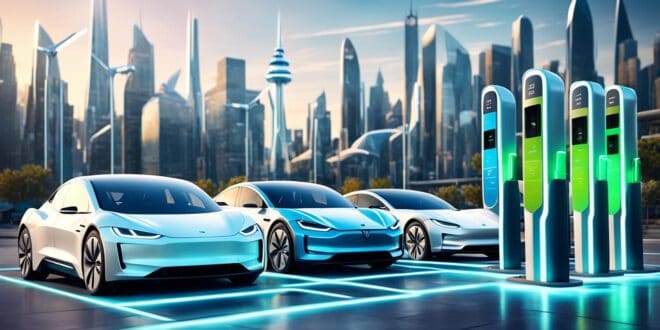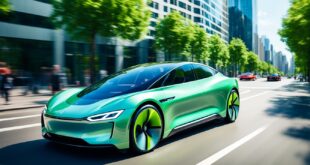Electric vehicles (EVs) have revolutionized the automotive industry, offering a glimpse into the future of eco-friendly transportation. With their sleek designs and sustainable performance, EVs have gained popularity worldwide. This surge in demand has not only sparked constant innovations in the electric car industry but has also highlighted the need for a robust charging infrastructure to support this growing trend.
By 2025, electric and hybrid electric vehicles are projected to dominate almost 30% of the car market, solidifying their place as the future of transportation. The number of electric vehicles is expected to skyrocket from 3 million to 125 million by 2030, with electric vehicles playing a significant role in the design of newly manufactured cars by 2050 in the United States.
Key Takeaways:
- Electric vehicles have gained popularity due to their sleek appearance and environmental benefits.
- The growth of EVs has resulted in constant innovations in the electric car industry.
- A robust charging infrastructure is crucial to accommodate the increasing demand for electric vehicles.
- By 2025, electric and hybrid electric vehicles are projected to dominate almost 30% of the car market.
- The number of electric vehicles is expected to skyrocket to 125 million by 2030.
Trends in the Electric Car Industry

The electric car industry is experiencing several important trends that are shaping its future. These trends include advancements in the vehicle-to-grid (V2G) market, improvements in battery longevity, and the gradual monopolization of the electric car industry.
Vehicle-to-Grid Market
The V2G market is projected to reach a value of $4.5 billion by 2024, indicating the significant potential of this technology. V2G allows electric vehicles to not only consume power but also feed excess energy back to the grid. This bidirectional energy flow creates a more efficient and sustainable energy ecosystem, contributing to grid flexibility and stability.
Battery Longevity
Battery technology is continuously evolving, leading to lower costs and improved performance for electric vehicles. With modernization in battery technology, electric vehicles are becoming more affordable compared to their gas-powered counterparts. These advancements in battery longevity are driving the accessibility and popularity of electric vehicles.
Monopolization of the Electric Car Industry
There is a clear trend towards designing full electric cars exclusively, with hybrids gradually being phased out. As a result, electric vehicles are expected to comprise 65-75% of all newly designed vehicles in the United States by 2050. This trend indicates the gradual monopolization of the electric car industry, marking a shift towards a more sustainable and eco-friendly transportation system.
These trends in the electric car industry highlight the growing importance and widespread adoption of electric vehicles. The vehicle-to-grid market, advancements in battery longevity, and the eventual monopolization of the industry pave the way for a cleaner and more sustainable future of transportation.
Environmental Benefits of Electric Vehicles

Electric vehicles (EVs) offer significant environmental benefits that contribute to sustainable transportation and address the issue of global warming. Compared to fueled vehicles, which are major sources of pollution, EVs help reduce air pollution and greenhouse gas emissions, thereby mitigating the negative health effects associated with air pollution.
Motor vehicles contribute to 75% of carbon monoxide pollution in the U.S. and one-third of the air pollution that produces smog. By transitioning to electric vehicles, we can significantly reduce these harmful emissions and improve air quality, leading to a healthier environment.
Additionally, the transportation sector accounts for approximately 27% of greenhouse gas emissions. By switching to EVs, we can significantly lower our carbon footprint and combat climate change. The use of electric vehicles helps reduce our dependence on fossil fuels and contributes to a more sustainable energy future.
Long Term Financial Advantages of Electric Vehicles

In addition to the environmental benefits they offer, electric vehicles provide significant long-term financial advantages. One of the key advantages is the potential for fuel savings. The cost of electricity is generally lower than gasoline, resulting in lower fuel costs for electric vehicle owners. This translates into long-term savings on transportation expenses.
Furthermore, electric vehicles contribute to domestic energy production in the United States. The country heavily relies on domestically produced electricity, reducing dependence on imported fossil fuels. In 2023, the U.S. used approximately nine billion barrels of fuel, with two-thirds of that allocated to transportation. By switching to electric vehicles, we can reduce our reliance on fossil fuels, resulting in both economic and environmental benefits.
Investing in electric vehicles not only provides individuals with long-term financial advantages in terms of fuel savings but also contributes to the overall energy independence and security of the country. By utilizing domestically produced electricity, we can establish a more sustainable and self-sufficient energy ecosystem.
Electric vehicles not only provide long-term financial benefits through fuel savings but also contribute to domestic energy production, fostering energy independence and security.
By embracing electric vehicles, we can pave the way for a greener and more sustainable future, both for individuals and the nation as a whole. The long-term financial advantages, coupled with the positive impact on the environment, make electric vehicles an attractive choice for individuals looking to invest in a more sustainable mode of transportation.
Range Anxiety and Infrastructure Challenges
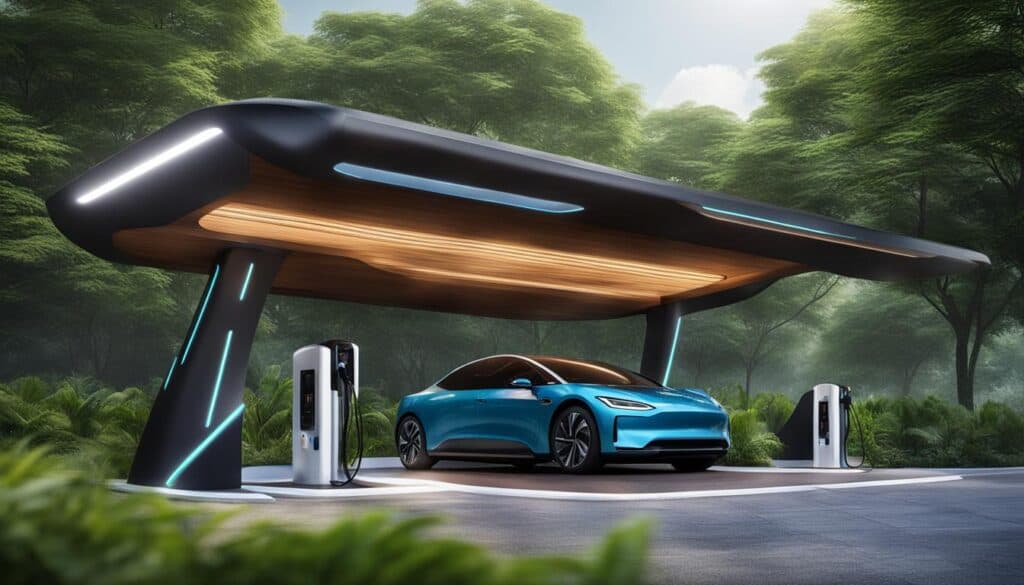
Range anxiety is a common concern among potential electric vehicle owners. The fear of running out of battery power and being stranded without a nearby charging station can deter people from switching to electric cars. To alleviate this anxiety, it is essential to have a robust and conveniently accessible charging infrastructure in place.
Currently, there are EV charging apps available that can help users locate nearby charging stations. These apps provide real-time information on the availability and location of charging points, making it easier for EV owners to plan their journeys. However, more work needs to be done to improve the overall infrastructure to cater to the growing number of electric vehicles on the road.
Charging time is another aspect that needs attention. While commercial charging stations are becoming more prevalent, the charging time for a full charge can still take around an hour or more. This can be a significant inconvenience for owners who are on the go or have limited time for charging.
Addressing range anxiety and improving charging infrastructure are critical steps in promoting the widespread adoption of electric vehicles. It involves expanding the number of charging stations, strategically placing them in areas with high demand, and improving the charging speed. Investing in fast-charging solutions and upgrading existing infrastructure will ensure that electric vehicle owners have a seamless and convenient charging experience.
Evolving technologies, such as wireless charging, are also being explored to further enhance the charging process. Wireless charging eliminates the need for physical connectors and allows for a more effortless and efficient charging experience.
Current Challenges in EV Charging Infrastructure:
- Limited number of charging stations
- Inconsistent charging speeds
- Non-standardized charger connectors
- Inadequate availability in rural areas
- Difficulty finding charging stations during peak hours
By addressing these challenges and continuously improving the charging infrastructure, range anxiety can be effectively reduced, making electric vehicles a more viable and attractive option for prospective buyers. The future of electric mobility depends on the seamless integration of electric vehicles into our daily lives, and a reliable charging infrastructure is the key to achieving this goal.
Short Term Financial Considerations

When considering purchasing an electric vehicle, one short-term concern that often arises is the higher upfront cost compared to traditional vehicles. It’s true that electric vehicles generally come with a higher price tag initially. For example, the lowest-cost Tesla Model 3, a popular electric car option, may be around 19% more expensive than the average new car in the United States.
While the upfront cost of electric vehicles may be a deterrent for some buyers, it’s essential to consider the long-term financial advantages and potential savings associated with operating an electric vehicle. When it comes to fuel costs, electric vehicles have a significant advantage over their gasoline-powered counterparts. The cost of electricity is generally lower than gasoline, resulting in substantial fuel savings for electric vehicle owners over time.
Moreover, the cost of electricity is also relatively stable compared to the volatility of gasoline prices. This stability in fuel costs allows electric vehicle owners to better plan and budget their expenses. Additionally, as the United States continues to shift towards domestically produced electricity, electric vehicle owners can contribute to reducing dependence on imported fossil fuels and support the growth of domestic energy production.
Furthermore, government incentives, such as tax credits and rebates, can help offset the upfront cost of electric vehicles and make them more financially accessible for consumers. These incentives vary by state and region, so it’s important to research and take advantage of available programs in your area.
While the higher upfront cost of electric vehicles may seem like a barrier, considering the long-term financial advantages, including fuel savings, stable energy costs, and potential government incentives, demonstrates the cost-effectiveness and potential for significant savings associated with operating an electric vehicle.
Advantages of Electric Vehicles:
- Lower long-term fuel costs compared to gasoline-powered vehicles
- Stable energy costs
- Reduced dependence on imported fossil fuels
- Potential government incentives
Electric vehicles may have a higher upfront cost, but the long-term financial advantages and potential savings make them an appealing and cost-effective choice for environmentally conscious consumers.
Future of Mobility and Innovation
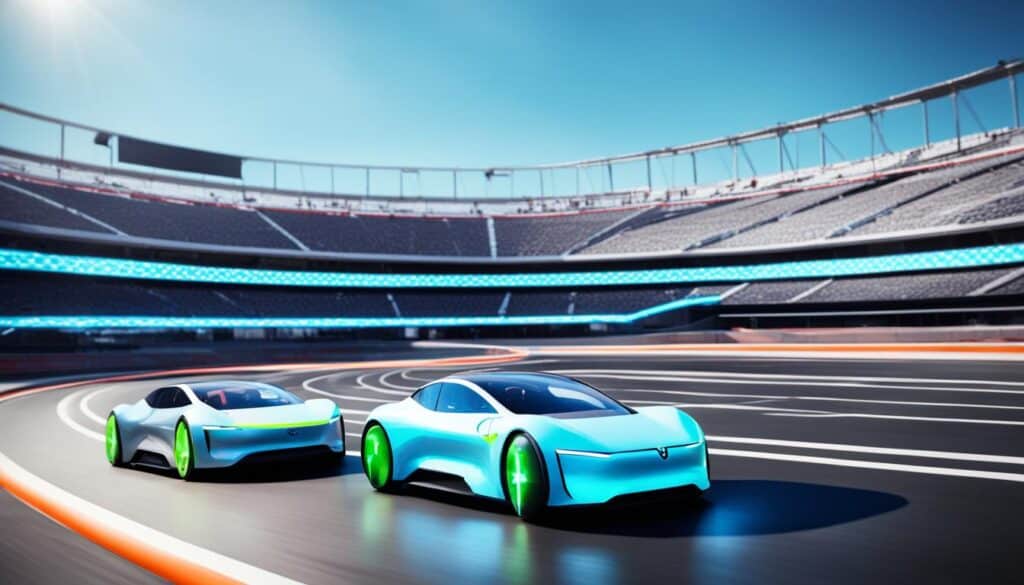
In this rapidly advancing era, the future of mobility lies in electric vehicles (EVs) and sustainable transportation alternatives. With ongoing innovation and advancements in technology, EVs are set to revolutionize the way we commute and travel.
As the world becomes more aware of the environmental impact of traditional modes of transportation, there is a growing demand for sustainable alternatives. Electric vehicles offer a greener and cleaner option, reducing greenhouse gas emissions and combating climate change. The future of mobility will prioritize sustainable transportation solutions to address these pressing global challenges.
The continuous growth and expansion of the electric vehicle market will drive further innovations in the industry. EV manufacturers and technology companies are investing heavily in research and development to improve battery technology, charging infrastructure, and overall performance of electric vehicles.
The future of mobility will also witness the development of new sustainable transportation alternatives, such as hydrogen fuel cell vehicles, autonomous vehicles, and shared mobility services. These innovations aim to provide efficient, convenient, and environmentally friendly options for commuters and travelers.
With the advent of electric vehicles, we can envision a future where urban areas are less polluted, noise levels are reduced, and commuting is more sustainable and enjoyable. The integration of renewable energy sources and smart technologies will further enhance the efficiency and sustainability of the transportation system.
The future of mobility is bright, with electric vehicles leading the way towards a cleaner, greener, and more sustainable transportation landscape.
Consumer Sentiment and Demand for Electric Vehicles

Consumer sentiment towards electric vehicles is undergoing a significant shift, with more individuals considering the purchase of an EV. As the demand for electric vehicles continues to rise, consumers are actively seeking exciting and innovative options that are both reliable and predictable in their performance. Manufacturers are keen to meet these evolving consumer expectations and preferences, driving them to introduce new features and advancements in technology to enhance the electric vehicle driving experience.
A better understanding of consumer sentiment is crucial for the future success and widespread adoption of electric vehicles. By aligning with consumer demands, manufacturers can capitalize on the growing demand and contribute to the ongoing transition towards sustainable transportation.
Consumer sentiment plays a pivotal role in shaping the future of the electric vehicle market. The collective preference for electric vehicles is driving the industry to create more innovative and user-friendly vehicles. With each technological advancement, electric vehicle manufacturers are positioning themselves to cater to the needs and expectations of their consumer base.
Innovations Driving the Electric Vehicle Industry

The electric vehicle industry is experiencing a rapid influx of innovations that are driving its growth and shaping the future of transportation. These advancements are focused on enhancing energy efficiency, improving user experience, and revolutionizing the way we charge electric vehicles.
Battery Technology: Enhanced Performance and Efficiency
One of the key areas of innovation in the electric vehicle industry is battery technology. Manufacturers are constantly improving energy density, charging speed, and overall performance of batteries. These advancements allow electric vehicles to achieve longer ranges and shorter charging times, addressing the concerns of range anxiety and making EVs more convenient for everyday use.
Moreover, innovations in battery management systems help optimize energy efficiency and battery longevity. These systems monitor and regulate the charging and discharging processes, ensuring optimal performance and extending the lifespan of the batteries.
Immersive Infotainment Systems
Electric vehicles are not just eco-friendly modes of transportation; they are also equipped with advanced digital infotainment systems that provide an immersive driving experience. These infotainment systems offer features such as intuitive touchscreens, voice commands, and seamless connectivity with smartphones. Drivers and passengers can enjoy entertainment, navigation, and communication functionalities while on the move.
This integration of technology not only enhances the overall user experience but also promotes safety by minimizing distractions and allowing drivers to stay focused on the road.
Wireless Charging: Convenient and Cable-Free
Another significant innovation driving the electric vehicle industry is wireless charging technology. With wireless charging, EV owners can say goodbye to cumbersome cables and connectors. Instead, they can simply park their electric vehicles over a wireless charging pad, and the vehicle will start charging automatically.
This technology eliminates the need for physical connections, making EV charging more convenient and user-friendly. It also paves the way for innovative charging infrastructure, such as wireless charging embedded in parking lots and streets, enabling seamless charging experiences for electric vehicle owners.
These innovations in battery technology, infotainment systems, and wireless charging are propelling the electric vehicle industry forward, attracting more consumers and contributing to its exponential growth. As technology continues to advance, we can expect even more groundbreaking innovations that will transform the way we drive, making electric vehicles the transportation mode of choice for a sustainable and greener future.
Vehicle-to-Grid Technology and Bidirectional Charging
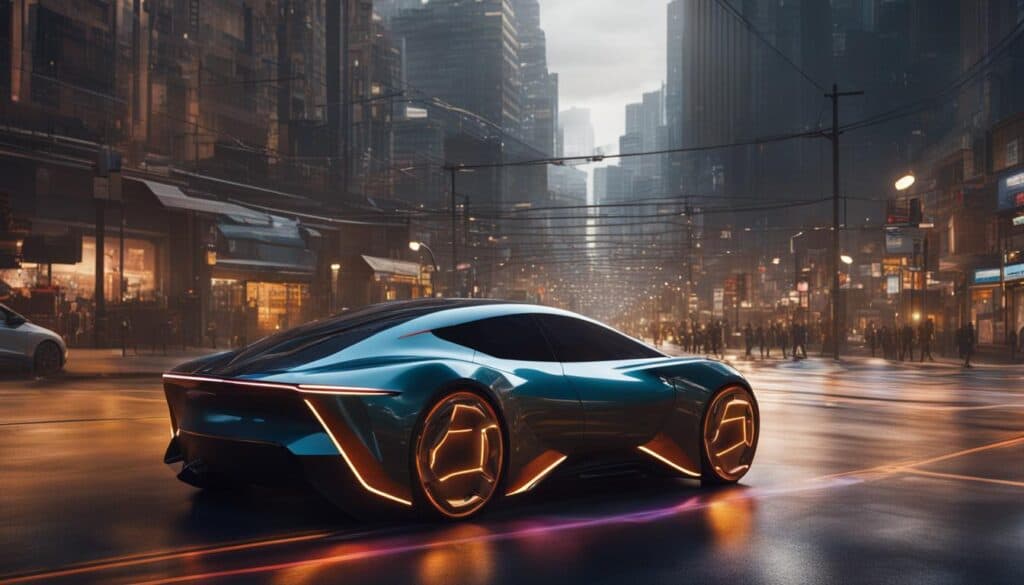
Vehicle-to-Grid (V2G) technology and bidirectional charging are revolutionizing the electric vehicle industry. With V2G capabilities, electric vehicles can not only consume power but also contribute excess energy back to the grid or other loads. This bidirectional flow of energy creates a more efficient and sustainable energy ecosystem.
Imagine electric vehicles serving as mobile energy storage units, enhancing grid stability and reducing the overall carbon footprint. Through V2G technology, electric vehicles contribute to grid flexibility, enabling the integration of renewable energy sources. This innovation opens up new possibilities for the advancement of electric vehicles and the transition to cleaner and greener transport systems.
“V2G technology allows electric vehicles to not only draw power from the grid but also return unused energy back, increasing the overall efficiency of the electrical system.”
By leveraging V2G technology and bidirectional charging, electric vehicles can become key players in the energy market, supporting grid demand during peak times and offering flexibility during low-demand periods. The ability to store energy allows electric vehicles to act as a buffer, balancing the grid and optimizing energy usage.
Furthermore, V2G technology enhances the sustainability of electric vehicles by enabling renewable energy sources to be efficiently harnessed and integrated into the grid. This reduces reliance on traditional energy sources and helps combat climate change by reducing greenhouse gas emissions.
Advantages of Vehicle-to-Grid Technology and Bidirectional Charging:
- Contribute to grid stability and flexibility
- Reduce the overall carbon footprint
- Optimize energy usage and balance the grid
- Enhance the integration of renewable energy sources
- Potential for cost savings and revenue generation for EV owners
The development and widespread implementation of V2G technology are crucial for the continued growth and success of the electric vehicle industry. As we embrace bidirectional charging and grid flexibility, we move closer towards a more sustainable and energy-efficient future.
Smart Charging and Optimization
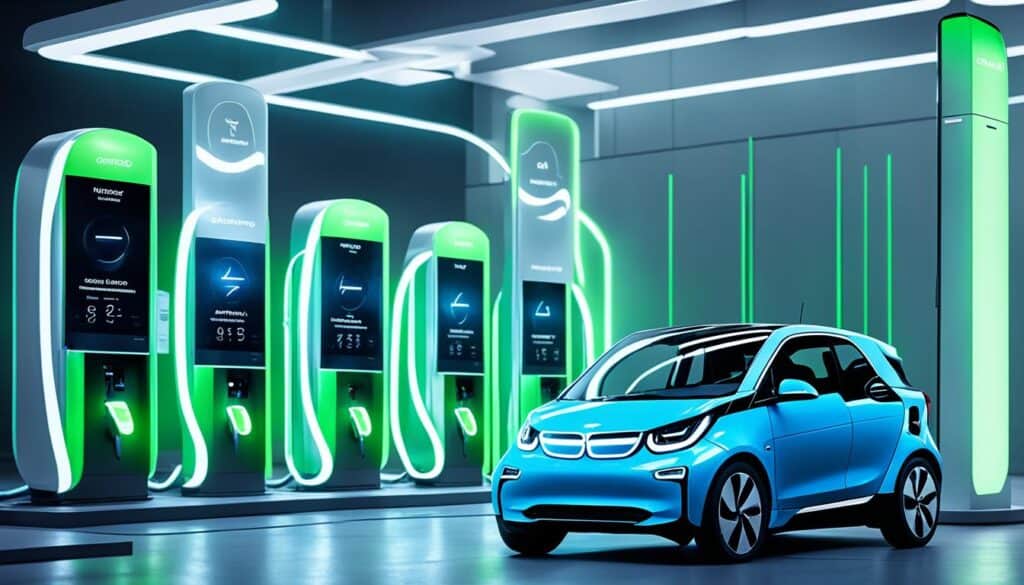
In the world of electric vehicles, smart charging is revolutionizing the way we power our cars. By leveraging advanced algorithms and optimization techniques, smart charging maximizes efficiency and minimizes strain on the power grid.
Smart charging takes into account various factors such as the time of day, energy demand, and even weather conditions. By analyzing these variables, EV owners can optimize their charging schedules to take advantage of off-peak hours or renewable energy sources.
One of the key benefits of smart charging is the cost-saving potential. By charging during off-peak hours when electricity rates are lower, EV owners can save money on their electricity bills. This not only benefits individual consumers but also contributes to the overall sustainability of electric vehicles by reducing the strain on the power grid.
Furthermore, smart charging plays a crucial role in promoting environmentally friendly charging practices. By utilizing renewable energy sources during the charging process, EV owners can minimize their carbon footprint and contribute to a greener future.
Smart charging is paving the way for a more efficient and sustainable charging infrastructure. By optimizing the charging process, we can ensure that electric vehicles are charged in the most cost-effective and environmentally friendly manner possible.
Continued advancements in smart charging algorithms promise even greater efficiency and sustainability. Researchers and engineers are constantly developing new optimization algorithms to enhance the charging experience for electric vehicle owners. These advancements will further streamline the charging process and make it more accessible for all.
The Future of Smart Charging
The future of smart charging holds immense potential. As electric vehicles continue to gain traction, the demand for smart charging solutions will inevitably increase. By integrating smart charging technology with renewable energy sources and grid management systems, we can create a seamless and sustainable charging ecosystem.
There is also the potential for smart charging to contribute to grid stability and help manage the dynamic nature of renewable energy generation. By strategically charging electric vehicles during periods of excess renewable energy production, smart charging can help balance the grid, making it more resilient and efficient.
Advancements in Battery Technology

Battery technology is a critical area of innovation in the electric vehicle industry. Ongoing improvements in battery technology have revolutionized the efficiency and performance of electric vehicles, creating a more sustainable and eco-friendly mode of transportation.
The Benefits of Improved Battery Technology
Improved battery technology offers several key benefits for electric vehicles:
- Higher Energy Density: New advancements have resulted in batteries with higher energy density, allowing electric vehicles to travel longer distances on a single charge.
- Faster Charging Times: With the development of improved charging infrastructure, electric vehicle owners can now charge their vehicles at a much faster rate, reducing the time needed for recharging.
- Increased Safety: Battery technology advancements have also led to enhanced safety measures, reducing the risk of accidents or malfunctions associated with battery usage.
The Rise of Solid-State Batteries
One notable advancement in battery technology is the emergence of solid-state batteries. Unlike traditional lithium-ion batteries that utilize liquid electrolytes, solid-state batteries incorporate solid materials as electrolytes, improving the overall performance of electric vehicles.
Solid-state batteries offer several advantages:
- Higher Energy Density: Solid-state batteries have a higher energy density, which means they can store more energy within a smaller volume, resulting in increased vehicle range.
- Faster Charging: These batteries support faster charging speeds, allowing electric vehicle owners to recharge their vehicles more quickly and conveniently.
- Increased Safety: Solid-state batteries are also safer than traditional lithium-ion batteries, as the use of solid materials reduces the risk of thermal runaway and battery fires.
As a result of these advancements, solid-state batteries are being viewed as a promising solution for improving the performance and viability of electric vehicles.
The Role of Battery Management Systems
Battery management systems (BMS) play a crucial role in optimizing the performance of electric vehicle batteries. These systems monitor and regulate the charging and discharging processes, ensuring the battery operates within their safe and efficient limits.
Battery management systems offer several key functions:
- Battery Monitoring: BMS continuously monitors the health and status of the battery, providing real-time information on its performance and remaining capacity.
- Optimized Charging: BMS utilizes sophisticated algorithms to control the charging process, ensuring the battery is charged at the optimal rate for maximum efficiency and longevity.
- Overcurrent Protection: BMS protects the battery from excessive currents, preventing potential damage and extending its lifespan.
- Temperature Control: BMS monitors and regulates the battery’s temperature to prevent overheating or excessive cooling, ensuring optimal performance and safety.
By actively managing and optimizing battery performance, battery management systems contribute to increased efficiency, longevity, and overall reliability of electric vehicle batteries.
The advancements in battery technology, including improved energy density, faster charging times, and the emergence of solid-state batteries, are propelling the electric vehicle industry forward. Additionally, battery management systems are integral in maximizing efficiency and optimizing the performance of electric vehicle batteries, ensuring a sustainable and reliable mode of transportation.
Seamless Payments and User Experience
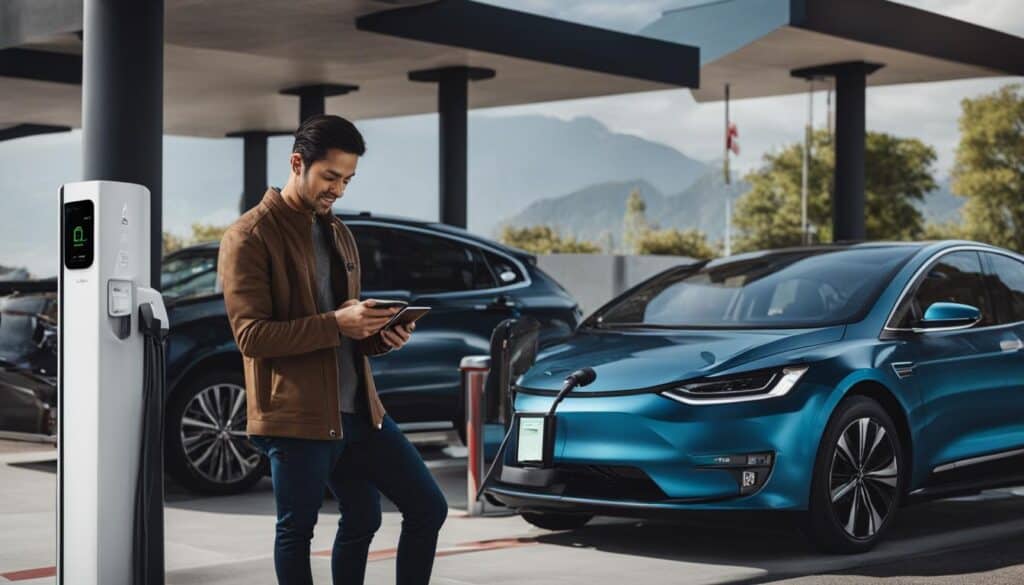
In the electric vehicle industry, seamless payment solutions are being developed to enhance the user experience when charging EVs. By integrating payment systems into charging infrastructure or mobile apps, the billing process becomes simplified and more user-friendly. This improvement in payment convenience supports the widespread adoption of electric vehicles.
Charging stations now implement various payment methods to provide a seamless experience for EV owners. QR codes, NFC payments, and RFID cards are among the innovative solutions being introduced. These payment methods enable users to easily initiate and complete transactions, streamlining the charging process.
Seamless payment solutions improve accessibility and convenience for EV owners.
With seamless payments, users no longer need to carry physical payment methods or worry about cash transactions. This advancement contributes to a more efficient and user-oriented charging experience, encouraging more individuals to switch to electric vehicles.
Benefits of Seamless Payments for EV Owners:
- Convenience: Users can easily initiate payments using their preferred method, eliminating the need for physical currency or payment cards.
- Efficiency: Seamless payments reduce the time and effort required for transaction completion, allowing for a smoother charging process.
- Flexibility: The availability of multiple payment options allows users to choose the method that suits them best, enhancing convenience and adaptability.
- User-friendly Experience: Integrated payment systems in charging infrastructure or apps create a more intuitive and straightforward experience for EV owners.
Seamless payments contribute to an improved user experience, making electric vehicle charging more convenient and accessible. As the electric vehicle industry continues to evolve, the integration of innovative payment solutions will play a vital role in the widespread adoption of eco-friendly transportation.
Innovation in the EV Market
The electric vehicle (EV) market is driven by continuous advancements in technology and sustainable transportation solutions. With a focus on developing more efficient, cost-effective, and environmentally friendly options, the industry is paving the way for a greener future. These innovative solutions not only address the challenges of traditional transportation but also offer improved performance and user experience.
-
Advancements in Electric Vehicle Technologies
The EV market is constantly evolving, with new technologies pushing the boundaries of what electric vehicles can achieve. Innovations in battery technology have led to increased energy density and faster charging times. These advancements have addressed concerns about range anxiety and made EVs more practical and convenient for everyday use.
-
Emphasis on Sustainability
Sustainability is a key focus in the EV market, with manufacturers striving to reduce the environmental impact of transportation. Through the use of renewable materials, lightweight designs, and efficient energy management systems, electric vehicles are becoming more sustainable and eco-friendly.
-
Improved Performance
Electric vehicles are not only sustainable but also offer exceptional performance. With instant torque and smooth acceleration, EVs provide a thrilling driving experience. Continuous innovation in electric motor technology, aerodynamics, and vehicle design has led to improved handling, stability, and overall performance.
-
Enhanced User Experience
Manufacturers are focused on providing a seamless and enjoyable user experience in electric vehicles. Advanced infotainment systems, intuitive interfaces, and connected features transform the way drivers interact with their vehicles. These technologies create a connected and convenient driving experience, making EVs more appealing to consumers.
The ongoing innovation in the EV market ensures the transition to a more sustainable and eco-friendly transportation system. With continuous advancements, electric vehicles are set to revolutionize the way we travel, offering a greener, more efficient, and exciting future.
The Future of Electric Vehicles
The future of electric vehicles (EVs) is poised to bring about a revolutionary shift in the automotive industry and transform the way we commute. With the increasing demand for eco-friendly and sustainable transportation, EVs are rapidly gaining popularity and becoming the preferred mode of travel for many.
One of the key drivers of the electric vehicle revolution is the continuous advancement in battery technology. As batteries become more efficient, with higher energy density and faster charging capabilities, range anxiety becomes a thing of the past. EVs are gradually achieving longer ranges and shorter charging times, making them more practical and convenient for everyday use.
Another crucial aspect of the electric vehicle future is the growth of charging infrastructure. Governments and private companies are investing heavily in expanding the network of charging stations to cater to the increasing number of EVs on the road. This infrastructure development provides EV owners with the confidence and convenience to embark on long journeys without worrying about running out of power.
Furthermore, smart technologies are fueling the electric vehicle revolution, offering features and functionalities that enhance the overall driving experience. From intelligent charging systems that optimize energy consumption to advanced connectivity and infotainment options, EVs are becoming smarter and more integrated into our digital lives. These innovations not only add value to the user experience but also drive the widespread adoption of electric vehicles.
 Fullersears
Fullersears
